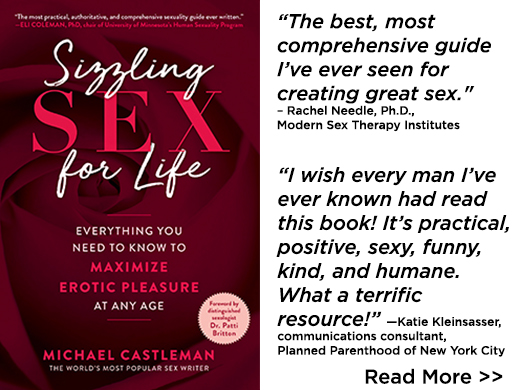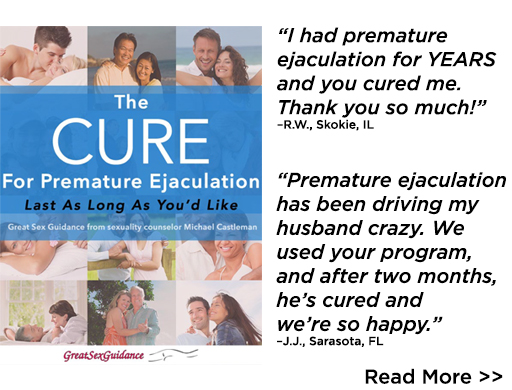
Scientific sex research began in the late 1940s, and during the 70 years since then, one finding has been replicated hundreds of times. Compared with men, women are considerably less likely to have orgasms. Men typically come during around 95 percent of partner nookie, but, depending on the study, the figure for women is only 50 to 70 percent.
Why? Largely because most women need direct clitoral caresses to come, and many don’t get enough of that—hand jobs and cunnilingus. Recently, researchers at Indiana University and Chapman University in Southern California have added to research literature that supports this. And for the first time, they compared orgasm rates based on sexual preference.
A Huge Study
The researchers analyzed an enormous database that included 52,588 U.S. adults:
- 26,032 heterosexual men
- 1,002 gay or bisexual men
- 1,452 lesbian or bisexual women
- 24,102 heterosexual women
As usual, the men enjoyed very high rates of partner-sex orgasm (94 percent), but the women were considerably less likely to climax (68 percent).
Then the investigators divided the women by sexual preference:
- Lesbian women: 86 percent reported being consistently orgasmic during partner sex.
- Bisexual women: 66 percent.
- Heterosexual women: 65 percent.
The lesbians were 20 percent more like to report orgasms during partner whoopie. They were almost as orgasmic as men.
The large majority of the bisexual women were mostly hetero, that is, usually sexual with men and only occasionally with women. That’s why the rate of orgasm was so close to the heterosexual women’s.
Compared with the straight and largely straight bisexual women, the lesbians were also more likely to report: extended deep kissing, more mutual whole-body massage, longer handjobs, and more oral sex (cunnilingus). They were also more likely to express love during sex, experiment sexually, and ask for what they wanted between the sheets.
The huge size of this sample makes the findings highly credible. These findings are also in line with a growing body of research showing that the way couples make love is the most important element in women’s rates of orgasm.
Hello, Clitoris!
For the large majority of heterosexual couples, lovemaking means penis-vagina intercourse (PVI)—and often not much else. Now, PVI can bring great pleasure to both men and women. It also provides sufficient penile stimulation for most men to get off.
But PVI doesn’t provide much direct clitoral stimulation. The clitoris, women’s orgasm button, sits outside the vagina, an inch or two above the opening. So even when men last a long time (and in every age group, many men don’t), the old in-out often may not excite the clitoris sufficiently for women to come.
A large body of sex research shows that only around 25 percent of women are consistently orgasmic from just PVI. Three-quarters require direct clitoral caresses for climax and satisfaction.
In the study, the lesbian women were much more likely to receive direct clitoral touch—hand jobs and cunnilingus—consequently, their rates of orgasm were 20 percent higher than the heterosexual women’s.
In addition, the lesbians also received two other things that most women say help them become aroused and orgasmic: lots of kissing and considerable time spent in mutual massage all over the body (foreplay). And the lesbians were more willing than heterosexual women to speak up and tell lovers what they wanted.
Demographics Don’t Matter Much
Until around a dozen years ago, sex researchers investigating the female orgasm deficit did not focus on how sex proceeded, but rather on women’s demographics and psychology:
- Demographics. As age, education, and income increase, women’s likelihood of orgasm increases somewhat.
- Beliefs. Compared with women who embrace religious fundamentalism and traditional sex roles (woman as a homemaker), those who espouse more liberal religious and social views are a little more likely to have orgasms.
- Relationships. As happiness with their relationships increases, women’s likelihood of orgasm increases modestly.
- Sexual trauma. Compared with women who have experienced incest, other sexual exploitation, and/or sexual assault, women free from sexual trauma are somewhat more likely to have orgasms.
But add up all these factors, and their sum total explains only a small fraction of women’s orgasm deficit. Meanwhile, focusing on the sex itself explains a great deal more.
Advice to Men Who Want to Be Good Lovers
Gentlemen, if you want your honeys to have orgasms every time, slow the pace of your lovemaking. Enjoy lots of deep kissing and mutual whole-body, that is, non-genital massage. If you make love with music playing, kiss and caress her all over for five or six standard-length songs before you reach between her legs.
When you do, gently massage her clitoris for another several songs. Many women’s clitorises are extremely sensitive to touch. Check in with her to make sure you’re providing pleasure and not causing discomfort. Ask, “Is this okay?” and then ask for coaching about how she likes her clit caressed. If your sweetie’s is super-sensitive, this is normal. Instead of mashing down on her button, caress around it.
Enjoy all the intercourse you like, but understand that she’s not likely to have orgasms that way. Before or after yours, go down on her and treat her to clitoral kisses/oral sex/cunnilingus. Again check in about this. If she’s super-sensitive, lick around her nub, not directly on it.
Even with lots of loving cunnilingus, it takes many perfectly normal, sexually functional women quite a while to come. Be patient. If they don’t come quickly, some women fear their lovers may get bored or suffer tongue fatigue. That anxiety distracts them from an erotic focus, making orgasm more difficult. Reassure her that she can take all the time she needs, that you love eating her, and are neither bored nor fatigued.
Finally…
For more suggestions on helping women have orgasms, read my article, Six Ways to Help Her Have Orgasms.
For women who feel orgasm-challenged, vibrators often help. Read my article, Vibrators – Myth vs. Reality.





